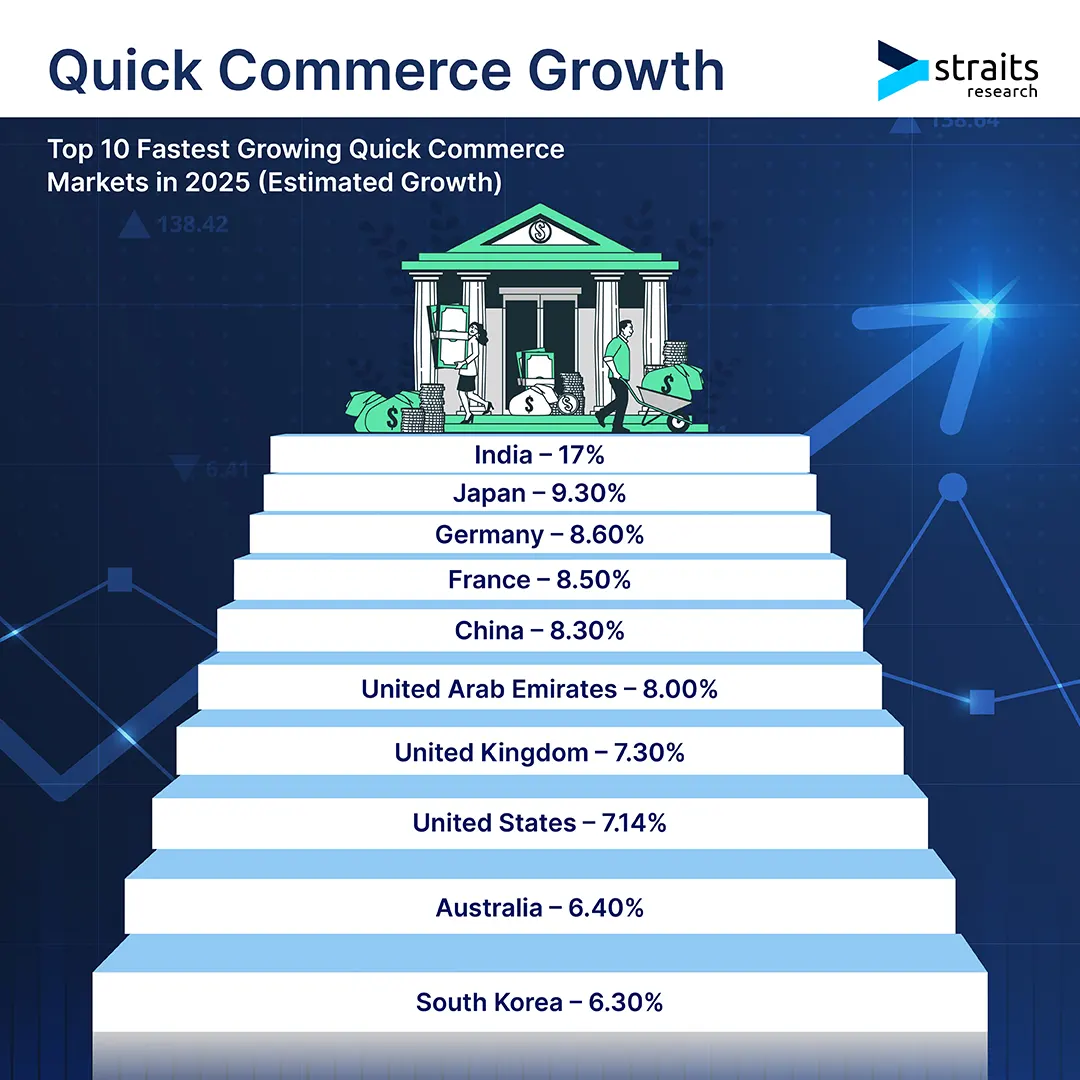10 Fastest Growing Quick Commerce Markets in 2025

Quick commerce, sometimes referred to as Q-commerce, has changed the retail industry by transforming how customers obtain necessities. Extreme convenience and quickness are prioritised in this business strategy, deliveries are usually finished in 10 to 30 minutes. Due to changes in consumer behaviour, technology developments, and improved logistics, quick commerce is becoming increasingly popular in key international marketplaces.
Market leader
India's quick commerce market is expected to expand at the fastest rate in 2025, with an estimated 17% growth rate. The rise in demand is driven by consumers' need for quick access to grocery and personal care items, busy urban lifestyles, and growing smartphone adoption. By the end of 2025, Blinkit is expected to have 46% of the Indian Q-commerce market, which is dominated by major competitors like Zepto, Swiggy, Instamart, JioMart, and Blinkit.
An important factor contributing to India's quick economic growth is the expansion of "dark stores" and urban warehouses, which simplify delivery operations. India's need for dark retail space is predicted to increase from 24 million square feet in 2023 to 37.6 million square feet in 2027. Furthermore, the industry's explosive growth is driving a boom in employment. Moreover, the rapid industry growth is fueling a surge in employment, with 2.4 million blue-collar jobs anticipated by 2027. These roles, which include logistics coordinators, warehouse associates, and delivery staff, pay an average of Rs. 22,600 a month.
India's quick commerce industry may find it difficult to maintain its present trajectory of expansion despite this pace. The increasing competition from Amazon, Reliance, and Flipkart might change market dynamics and hamper growth.
Growth trends and consumer behaviour
Although India has the fastest growth rate, other markets are also expanding quickly. With its tech-savvy populace and crowded cities that allow for speedy delivery, Japan comes in second with a growth rate of 9.3%. European adoption is being driven by well-known online grocery platforms like REWE and Edeka, with Germany (8.6%) and France (8.5%) leading the way. In the meantime, two important emerging markets that take advantage of growing disposable incomes and digital payment methods are China (8.3%) and the United Arab Emirates (8%).
The United Kingdom (7.3%) and the United States (7.14%) are also seeing widespread adoption, while Australia (6.4%) and South Korea (6.3%) round out the top 10 fastest-growing quick commerce markets. Furthermore, the core of the Q-commerce revolution is shifting consumer preferences. According to a recent survey on online shopping in India, 29% of urban residents say they prefer to buy groceries online over electronics and clothing.
By 2029, there will be 51.9 million grocery delivery consumers in Japan, with a 35.8% user penetration rate by 2025. In the same way, by 2025, grocery delivery services will have a 28.3% market share in France. With cities like Mumbai, Delhi, and Chennai dominating in delivery volumes, the rapid commerce sector in India has grown beyond groceries to encompass food, apparel, medications, and even documents. In contrast, the most sought-after Q-commerce items in Japan in 2024 are ready-to-eat meals, convenience snacks, personal care products, fresh groceries, and domestic necessities.
Interestingly, in Germany, clothing and shoes remain the top online shopping categories, with 50% and 40% of consumers preferring to buy these items online. The Grocery Delivery market in Germany is projected to reach 22.6 million users by 2029.
The worldwide grocery retail landscape is changing due to Q-commerce's development. In 2021, grocery retail sales in India, including both contemporary grocery stores and traditional Kirana stores, totalled Rs. 36 trillion. By 2030, this amount is anticipated to increase to Rs. 60 trillion, reflecting the market's growth.
Among India's quick commerce players, Zepto reported the highest revenue growth in 2023, exceeding 1,000%, while BigBasket saw the lowest growth at just 5%. This stark contrast shows the rapid expansion of newer competitors in the space.
The revolution in Q-commerce is still developing. Although convenience is still the primary driver, competition from e-commerce giants like Amazon and Flipkart may influence the direction of the sector going forward. Quick commerce can transform retail in the future as global markets accept the need for quick delivery, setting efficiency and speed as the new benchmark for customer purchasing experiences.




